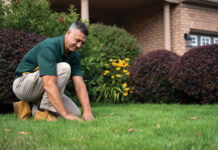KNOXVILLE, Tenn. – Boxwood is a bread and butter plant for landscapers and gardeners. It can grow under a wide range of conditions in Tennessee, but a disease that’s relatively new to the state may threaten the popular plant.
Boxwood blight is was first found in the U.S. in 2012 and first documented in Tennessee in 2014. Alan Windham, a plant pathologist with University of Tennessee Extension’s Soil, Plant and Pest Center, says the disease has been found in garden centers as well as landscape plantings. “The infected plants came from out-of-state nurseries,” he said. “Boxwood blight has not been found in production nurseries in Tennessee.”
Boxwood blight is a fungal disease that starts as a leaf spot, but can spread to blight all foliage on susceptible boxwood cultivars. One of the most susceptible cultivars is the dwarf English boxwood (Buxus sempervirens ‘Suffruticosa’) – a plant that is often used in formal gardens.
Windham has bad news for homeowners or landscape managers who discover that their plants are infected. “In most cases, plants affected by boxwood blight should be removed and destroyed,” recommends Windham. “Fungicides can be used to protect healthy boxwood, but not cure infected boxwood.“
How should you protect boxwoods from boxwood blight? Windham says the first step is to be aware of the problem. He recommends learning to recognize the symptoms and inspect plants prior to purchase. He also says you should isolate new plants for a few weeks if they are to be planted near established boxwood, then inspect again for symptoms prior to planting.
This was originally posted on UT Extension website here.











![[VIDEO] Dickies®: Discover Workwear That’s Anything But Uniform](https://turfmagazine.com/wp-content/uploads/2023/06/1647663814-4b1a2a7742790a9b1e97a3b963477850192e1d6a9dfba9b07214a77bae25d6e3-d-218x150.jpg)






























![[VIDEO] Dickies®: Discover Workwear That’s Anything But Uniform](https://turfmagazine.com/wp-content/uploads/2023/06/1647663814-4b1a2a7742790a9b1e97a3b963477850192e1d6a9dfba9b07214a77bae25d6e3-d-324x160.jpg)